Getting Your New York Class D License: A Clear Step-by-Step Guide
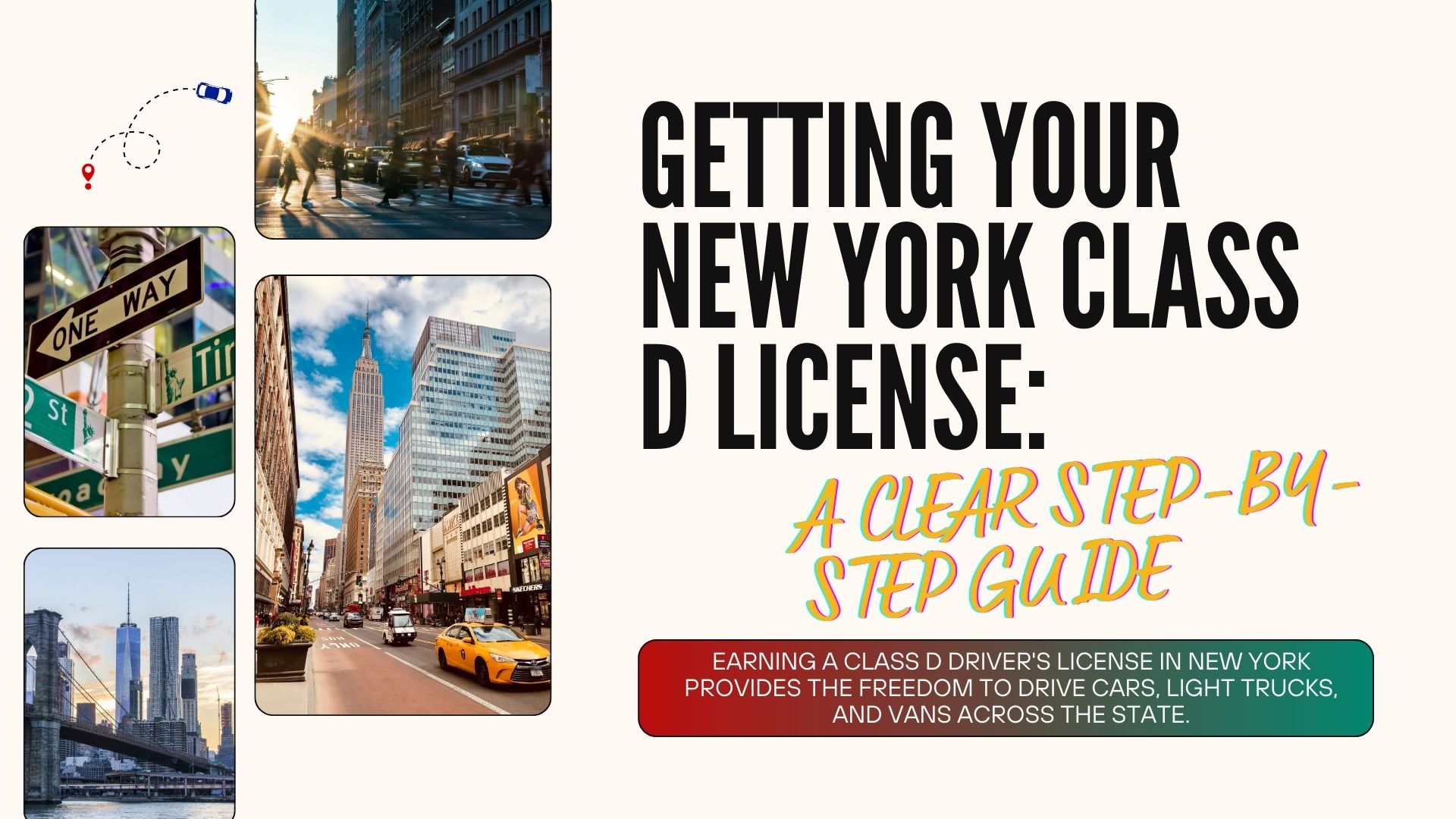
Table of Contents
Obtaining your Class D driver's license is an exciting milestone in New York. This license grants driving privileges and newfound freedom to operate vehicles like cars, light trucks, and vans across the state.
A Class D is the most common type of license for everyday drivers. It allows you to drive passenger vehicles below 26,000 pounds gross vehicle weight rating (GVWR). Having this credential unlocks work and life opportunities, like driving for rideshare services or delivering goods.
This comprehensive guide will walk you through all the steps and requirements to get a Class D license in New York. We’ll cover everything from age limits and fees to taking your written exam and road test. You’ll also learn about the different license types, like the REAL ID and Enhanced licenses.
By the end, you'll understand exactly how to:
- Get your New York learner's permit
- Pass vision and knowledge tests
- Complete driver's education
- Schedule and ace your road test
- Obtain your Class D license document
So if you’re ready to start the exciting process of earning your driver’s license, let’s get rolling! This guide will prepare you to pass your tests and get licensed with confidence.
Call Us Today 6AM-10PM
Or fill out the form 24/7
Our team is here to guide you with promotions, instructor availability, and the best training package for you.
What is a Class D License in New York?
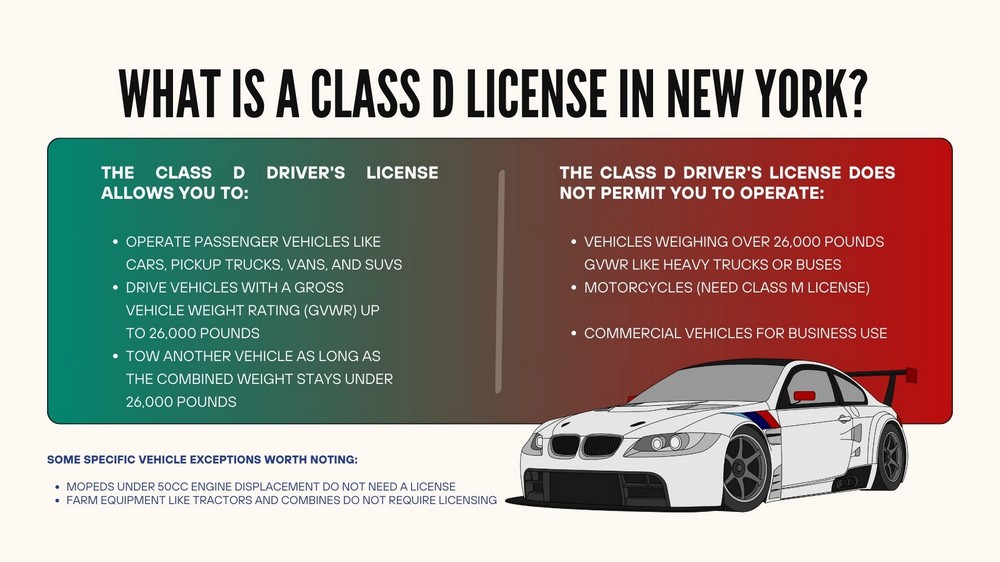
A Class D driver's license is the most common license type for everyday drivers in New York. This license has specific privileges and vehicle operation guidelines:
The Class D driver's license allows you to:
- Operate passenger vehicles like cars, pickup trucks, vans, and SUVs
- Drive vehicles with a gross vehicle weight rating (GVWR) up to 26,000 pounds
- Tow another vehicle as long as the combined weight stays under 26,000 pounds
The Class D driver's license does NOT permit you to operate:
- Vehicles weighing over 26,000 pounds GVWR like heavy trucks or buses
- Motorcycles (need Class M license)
- Commercial vehicles for business use
So in short, the New York Class D opens personal driving privileges only. It covers you for most regular automobiles used to transport yourself, family, or friends.
Some specific vehicle exceptions worth noting:
- Mopeds under 50cc engine displacement do not need a license
- Farm equipment like tractors and combines do not require licensing
To drive those vehicles commercially or on public roads for non-farming purposes, you would need a commercial driver's license (CDL).
Now let's summarize the other main New York license classes:
|
License Class |
Vehicle Types Covered |
|
Class A (CDL) |
Tractor trailers, heavy trucks |
|
Class B (CDL) |
Large buses, dump trucks |
|
Class C (CDL) |
Smaller commercial vehicles |
|
Class E |
Taxis, limos, rideshare vehicles |
|
Class M |
Motorcycles |
You must determine the proper class based on the vehicle's purpose of operation. For personal transportation, though, the Class D license will cover most everyday drivers in New York.
Age Requirements and Getting Started
To apply for your Class D license in New York, you must meet some minimum age requirements:
- 18 years old to apply for a full Class D license
- 17 years old to apply if you have completed an approved driver's education course
Getting a Learner's Permit
The first step is getting a learner's permit, which allows you to legally practice driving with supervision.
Here's how to apply for your learner's permit:
- Schedule an appointment at your local DMV office
- Complete the application form MV-44
- Provide proof of identification and residency
- Pay the fee (around $100 for licenses under 18)
- Pass vision and written tests
Once approved, you will receive your printed photo learner's permit. This allows you to start practicing driving as long as you have a supervising driver over 21 with a valid license in the front seat.
You must hold your learner's permit for 6 months before scheduling your road test. Use this time to practice and log at least 50 hours driving with supervision. This lays the groundwork for safe driving habits and prepares you to pass your eventual road test.
Some key learner's permit restrictions to remember in New York:
- No driving in New York City or on highways
- No driving 9PM-5AM as a junior permit holder
- Limit of 1 non-family passenger under 21
Following the learner phase requirements properly sets you up for ultimate success behind the wheel.
Call Us Today 6AM-10PM
Or fill out the form 24/7
Our team is here to guide you with promotions, instructor availability, and the best training package for you.
Preparing for Your Class D License

When your learner's permit period ends, it's time to prepare for your exams. Obtaining your Class D license requires passing vision, written, and road tests.
A. Written Knowledge Test
The knowledge exam covers critical topics like:
- Traffic laws and regulations
- Road signs and signals
- Safe driving techniques
- Alcohol and traffic safety
The test contains 20 multiple choice questions. You must answer 14 correctly to pass. There may be additional questions on road signs.
Some tips for passing your knowledge test:
- Study the New York DMV driver's manual
- Take free practice permit tests
- Review key topics like right-of-way rules
- Memorize meanings of common road signs
Many online resources and driving schools offer written test preparation. Leverage these to feel fully prepared when exam day arrives.
B. Vision Test
The vision test ensures you can safely operate a motor vehicle. You must have at least 20/40 vision in one eye with or without corrective lenses.
If you wear glasses or contacts, bring them to your test. Limited exceptions exist for those with vision conditions - discuss accommodations with your local DMV.
Passing this vision screening is required to qualify for a learner's permit and ultimately obtain your license.
With diligent studying for the written exam and solid vision, you'll knock out the knowledge prerequisites in no time. Next comes the critical road test.
Passing the Road Test
The road test is the final step before getting your Class D license. You'll drive on public roads with an examiner who evaluates your maneuvering and safety.
Maneuvers Tested
You may be asked to execute moves like:
- 3-point turns
- Backing up straight
- Parallel parking
- Obeying traffic signs
- Changing lanes
- Turning through intersections
The full test is about 20 minutes. You'll drive in residential and commercial areas.
Tips to Pass
- Study the road test maneuvers
- Practice commonly tested skills
- Perform a vehicle safety check
- Follow all traffic laws
- Drive calmly, smoothly, and focused
Scoring is based on accumulating 10 points or less. Serious mistakes lead to automatic failure.
If you don't pass on the first try, you can retest for a $10 fee. Retake the test seriously and continue practicing problem areas.
Booking multiple tests in advance can also ease nerves. This lets you treat the first as a "warmup" while having a backup slot if needed.
With diligence in preparing through real-world driving practice, you'll have the ability to pass this critical test.
Types of Class D Licenses
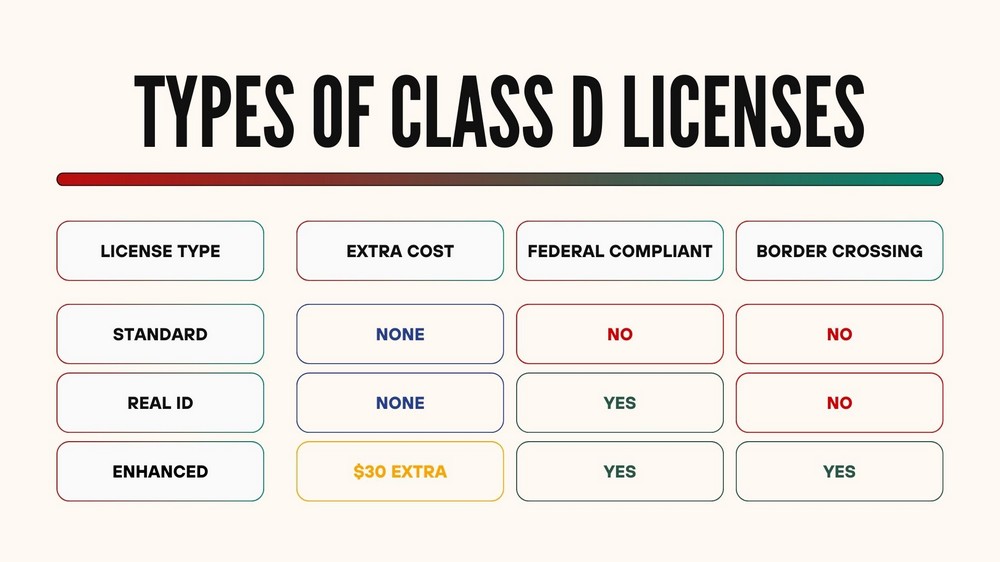
When applying for your license, you can choose between three types:
- Standard
- REAL ID
- Enhanced
Standard License
A standard Class D license works for driving purposes and identification. However, starting May 2023, you'll need additional ID to board domestic flights per the REAL ID Act.
REAL ID License
A REAL ID license can be used to board domestic flights and enter some federal facilities. It has a star marking to indicate compliance. REAL IDs have stricter documentation requirements regarding proof of identity and residency.
Enhanced License
An enhanced license enables driving plus crossing the border from Canada, Mexico, and some Caribbean countries without a passport. It costs an additional $30. Like a REAL ID, it also works for domestic flights and federal sites.
Here's a comparison of the license types:
|
License Type |
Extra Cost |
Federal Compliant |
Border Crossing |
|
Standard |
None |
No |
No |
|
REAL ID |
None |
Yes |
No |
|
Enhanced |
$30 extra |
Yes |
Yes |
Choose the right one based on your needs:
- If you don't fly often or cross borders, a Standard Class D is fine
- If you fly domestically but don't frequently cross borders, get a REAL ID
- If you want the maximum functionality including border crossing privileges, choose the Enhanced
Either Enhanced or REAL ID works well if needing licenses for domestic air travel or facility access.
Additional Resources and FAQs
Here are some helpful DMV resources for getting your New York license:
- DMV website - Official information and checklists
- Road test tips - Prepare for the driving exam
- Local office locator - Find the closest DMV branch
Also, review some frequent questions about New York Class D licenses:
Can I renew my learner's permit if needed?
Yes, you can renew your learner's permit once for an additional year if you need more time to prepare for exams.
What if my license expires soon after passing exams?
The DMV ties the expiration date to your learner's permit validity period. So renew early if it may expire soon to maximize the length of your initial license.
Are there license restrictions for junior holders under 18?
Special license restrictions under the graduated driver licensing program apply to those under 18. These include passenger, night driving, and cell phone limits to prioritize safety for newest drivers.
For personalized assistance with obtaining your license, don't hesitate to call your regional DMV office:
- New York City: (212) 645-5550
- Long Island: (718) 477-4820
- Upstate New York: (518) 486-9786
Their team can clarify anything related to New York's Class D requirements.
You're Ready to Get Your New York Class D License!
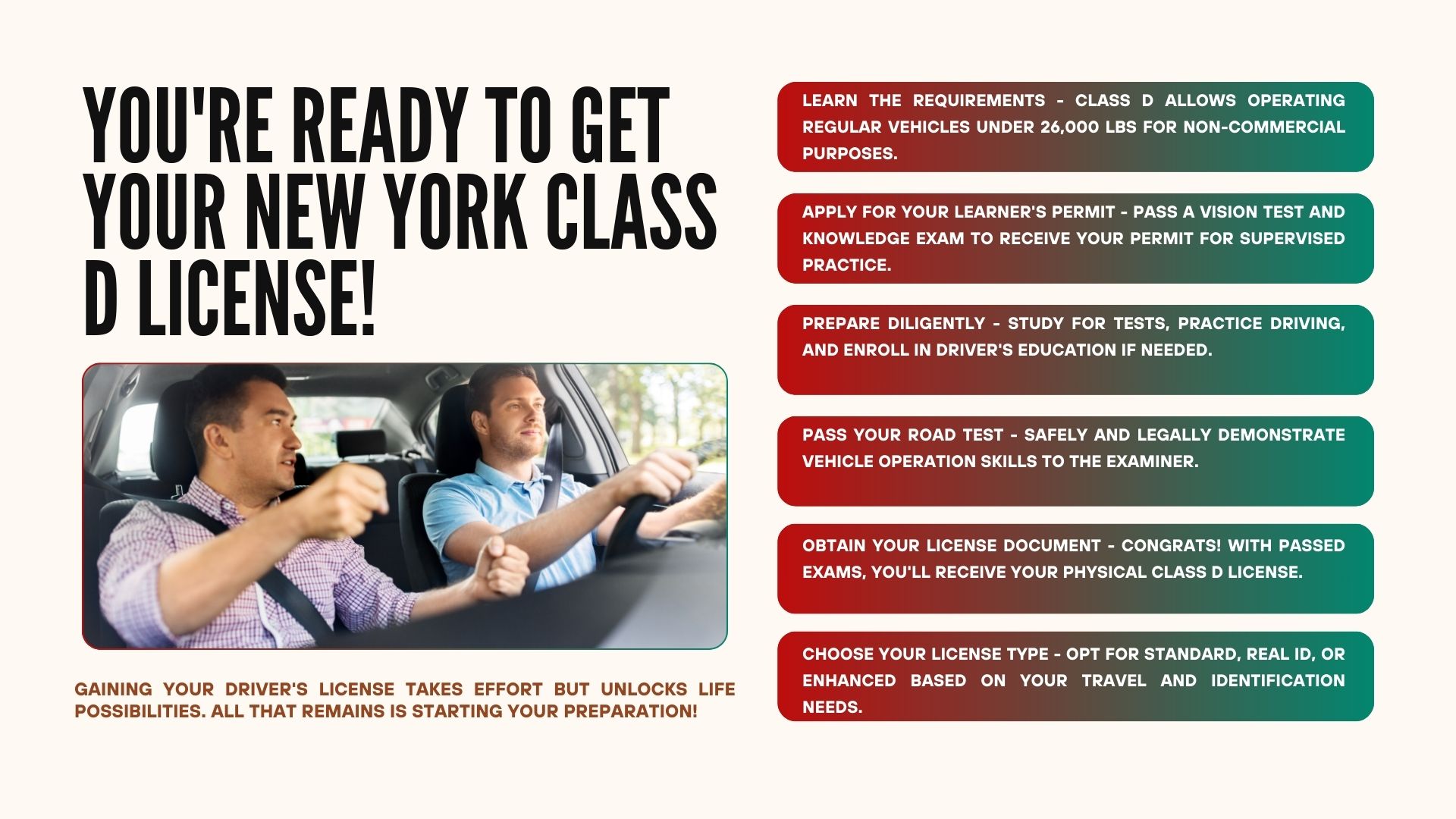
Obtaining your Class D driver's license marks an important life milestone. This license grants driving independence with vehicles for personal use.
We've covered all the key steps for new drivers in New York seeking this freedom:
- Learn the requirements - Class D allows operating regular vehicles under 26,000 lbs for non-commercial purposes.
- Apply for your learner's permit - Pass a vision test and knowledge exam to receive your permit for supervised practice.
- Prepare diligently - Study for tests, practice driving, and enroll in driver's education if needed.
- Pass your road test - Safely and legally demonstrate vehicle operation skills to the examiner.
- Obtain your license document - Congrats! With passed exams, you'll receive your physical Class D license.
- Choose your license type - Opt for Standard, REAL ID, or Enhanced based on your travel and identification needs.
We've also covered helpful DMV learning resources, license renewals, common FAQs, and more.
Gaining your driver's license takes effort but unlocks life possibilities. All that remains is starting your preparation! We encourage you to begin the rewarding process of qualifying for and obtaining your New York Class D license today.
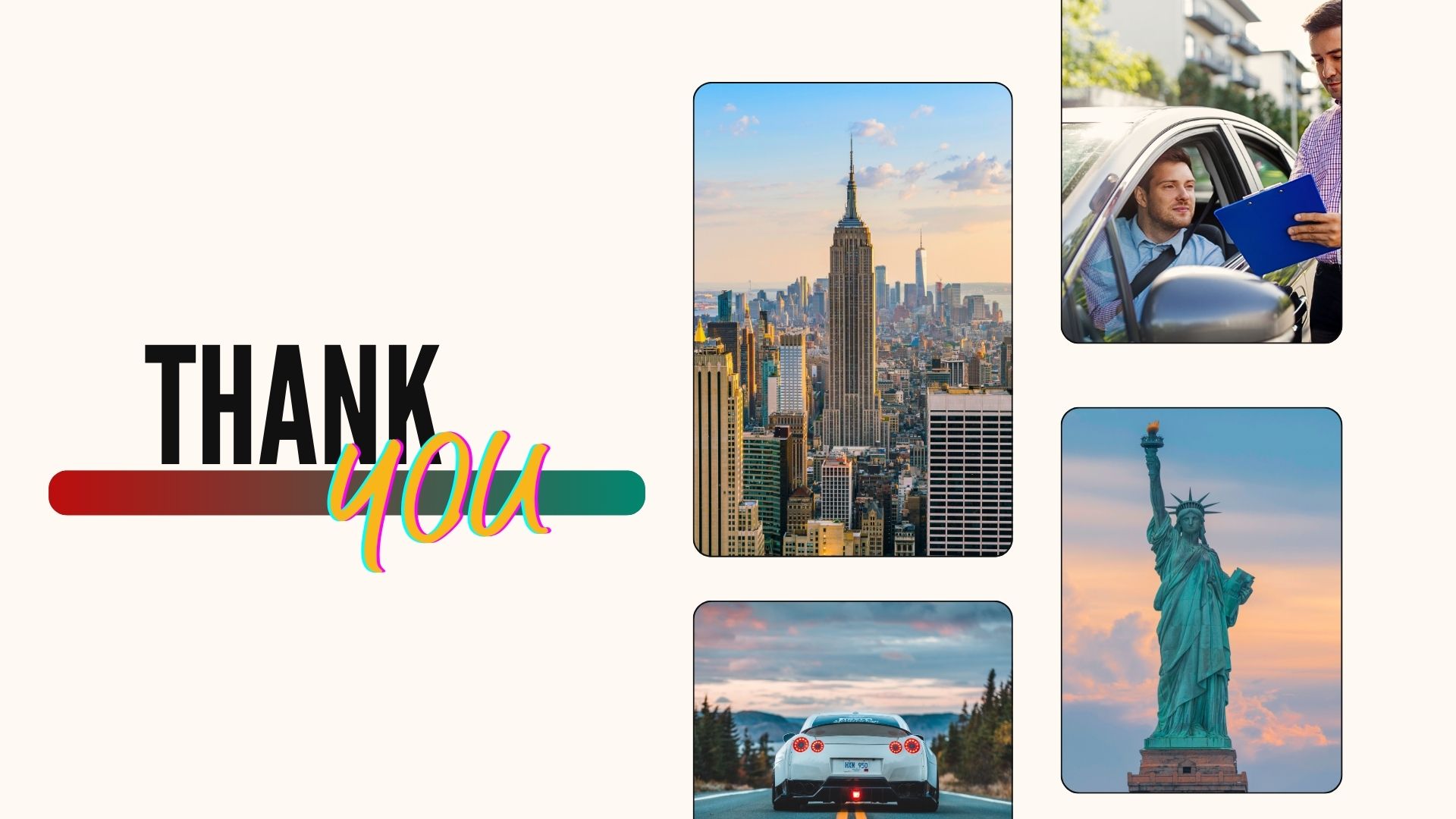
Call Us Today 6AM-10PM
Or fill out the form 24/7
Our team is here to guide you with promotions, instructor availability, and the best training package for you.
Frequently Asked Questions
-
What are the steps to getting a commercial driver's license (CDL) in New York?
To get a CDL in New York, you must: Obtain a Class D, Class E, or non-CDL Class C driver's license Study the commercial driver's manual and apply for a commercial learner's permit (CLP) Pass necessary knowledge exams for the type of CDL and endorsements needed Complete entry-level driver training course if applying for a new CDL or certain new endorsements Schedule and pass your CDL road skills test Apply for your commercial license after passing the road test
-
Can I use an out-of-state learner's permit to practice driving in New York?
Yes, you may drive with an out-of-state learner's permit in New York if: You are at least 16 years old The permit is valid for driving outside of the issuing state You obey all permit restrictions for New York and the issuing state You meet New York's graduated driver licensing restrictions if under 18 However, you cannot exchange an out-of-state permit for a New York permit.
-
What is the minimum age to get a motorcycle license in New York?
The minimum ages for motorcycle licenses in New York are: 16 years old: Class MJ junior license 17 years old: Class M standard license (with driver's education) 18 years old: Class M standard license Those under 18 have restrictions on motorcycle operation until they qualify for their full Class M motorcycle license.
-
Can I renew my New York driver’s license online?
In some cases yes, you can renew your New York license online. However, you generally need to renew in person if: Converting license to a REAL ID or Enhanced version Reinstating a conditional, suspended or revoked license Updating the license photo Making name, address, or other key changes Check license renewal eligibility requirements before your expiration date.
 English
English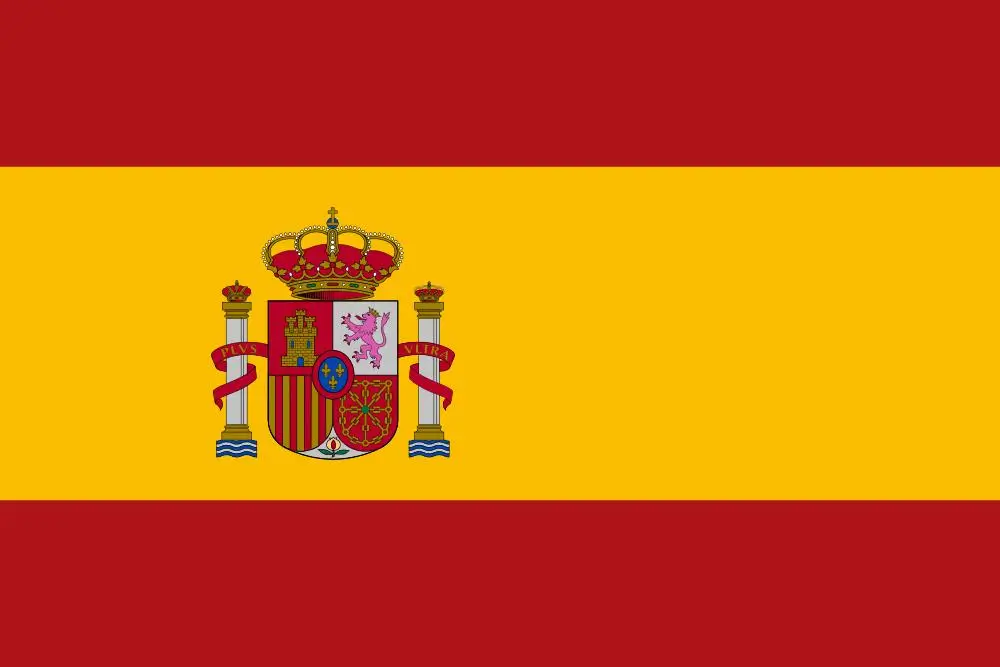 Spanish
Spanish 

